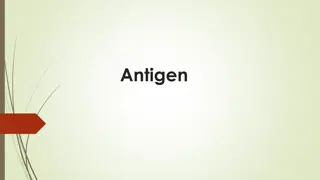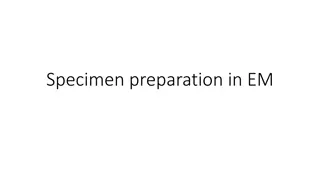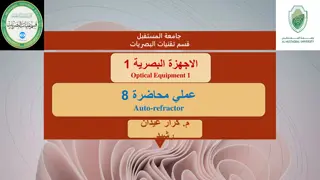Understanding Complement Fixation Test (CFT) in Immunology
Complement Fixation Test (CFT) is a key immunological method used to detect specific antibodies in a patient's serum by using complement proteins. This test involves the stages of incubation with antigens, inactivated serum, and complement, followed by the indicator stage using sheep red blood cells. The test requires specific reagents and careful standardization for accurate results. Understanding the steps and components of CFT is crucial for its successful application in diagnosing various diseases.
Download Presentation

Please find below an Image/Link to download the presentation.
The content on the website is provided AS IS for your information and personal use only. It may not be sold, licensed, or shared on other websites without obtaining consent from the author. Download presentation by click this link. If you encounter any issues during the download, it is possible that the publisher has removed the file from their server.
E N D
Presentation Transcript
Antigen Antibody Reaction (3) By:Reham Alahmadi OCT 2018
Complement Fixation Test CFT is an immunological test, which uses complement to detect the presence of specific antibody in patient s serum Complement : proteins Only binds to Ag-Ab complex (Complement Fixation) When Free, it has lytic properties : the ability to lyse antibody-coated sheep red blood cells.
Do not produce any visible precipitation that can be observed. Therefore, the indicator system*** is needed *** indicator system: Complement Sheep red blood cells (RBC) Anti- Sheep red blood cells antibody Requires serial dilution of the patient s serum
MATERIALS AND REAGENTS The test requires five reagents and is carried out in two steps. Test System Antigen: It may be soluble or particulate. Antibody: Human serum (May or may not containAntibody towards specific Antigen) Complement: It is pooled serum obtained from 4 to 5 guinea pigs. It should be fresh or specially preserved as the complement activity is heat labile (stored at - 30 C in small fractions). The complement activity should be initially standardized before using in the test. Indicator System (Haemolytic system) Erythrocytes: Sheep RBC Amboceptor (Hemolysin): Rabbit antibody to sheep red cells prepared by inoculating sheep erythrocytes into rabbit under standard immunization protocol.
COMPLEMENT FIXATION STAGE FIRST STEP 02 01 A known antigen and inactivated patient s serum are incubated with a standardized, limited amount of complement. patient s serum is heated at 56 C for 30 minutes to inactivate endogenous complement which may disturb the test calibration. 03 However, if there is no antibody in the patient s serum, there will be no formation of antigen-antibody complex, thus complement will not be fixed but will remain free (In the indicator stage this complement will react with RBC coated with antibody to sheep RBC ). 04 If the serum contains specific complement activating antibody, the complement will be activated or fixed by the antigen-antibody complex.
INDICATOR STAGE SECOND STEP 01 The second step detects whether complement has been utilized in the first step or not. This is done by adding the indicator system. If the complement is fixed in the first step owing to the presence of antibody there will be no complement left to fix to the indicator system. There won t be any lysis of RBCs 02 However, if there is no specific antibody in the patient s serum, there will be no antigen-antibody complex, therefore, complement will be present free or unfixed in the mixture. This unfixed complement will now react with the anti body- coated sheep RBCs to bring about their lysis. 03
POSITIVE TEST Step 1: At 37 C Complement gets fixed Antigen + Antibody + Complement (from serum) 1 Hour Step 2: At 37 C Fixed Complement complex + Haemolytic system No haemolysis 1 Hour
NEGATIVE TEST Step 1: At 37 C Antigen + Antibody absent + Complement Complement not fixed 1 Hour Step 2: At 37 C Free Complement + Haemolytic system Haemolysis 1 Hour
Interpretation + In the positive test : The available complement is fixed by Ag-Ab complex and no hemolysis of sheep RBCs occurs. So the test is positive for presence of antibodies. - In the negative test : NoAg-Ab reaction occurs and the com plement is free. This free complement binds to the complex of sheep RBC and it s antibody to cause hemolysis, causing the development of pink color. Controls should be used along with the test to ensure that Antigen and serum are not anti complimentary The appropriate amount of complement is used and The sheep red blood cells do not undergo autolysis C
RESULTSAND INTERPRETATIONS: 1 3 2 4 1 2 3 4 A POSITIVE No haemolysis POSITIVE No haemolysis NEGATIVE NEGATIVE A Haemolysis Haemolysis POSITIVE No haemolysis POSITIVE No haemolysis POSITIVE No haemolysis NEGATIVE B B Haemolysis
ADVANTAGES AND DISADVANTAGES OF CFT Advantages 1. Ability to screen against a large number of viral and bacterial infections at the same time. 2. Economical. Disadvantages 1. Not sensitive - cannot be used for immunity screening 2. Time consuming and labor intensive 3. Often non-specific e.g. cross-reactivity between HSV and VZV
NEUTRALIZATION TEST
NEUTRALIZATION it is an antigen-antibody reaction in which the harmful effects of a bacterial exotoxin or a virus are blocked by specific antibodies. For example when the serum antibody neutralize the toxic substances produced by the diphtheria pathogen, Corynebacterium diphtheriae. Such as a neutralizing substance, which is called an Antitoxin .
Neutralization Antitoxin: is a specific antibody produced by a host as it respond to a bacterial exotoxin or its corresponding toxoid (inactivated). So the antitoxin combines with the exotoxin to neutralize it.
VIRAL HEMAGGLUTINATION INHIBITION TEST It is one of most frequently used neutralization test The test is used in the diagnosis of influenza, measles mumps, and a number of other infections caused by viruses that can agglutinate red blood cells (hemagglutination). If the person s serum contains antibodies against these viruses, these antibodies will react with the viruses and neutralize them. The HA inhibition assay - YouTube























